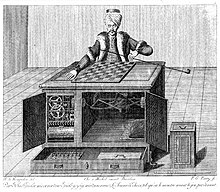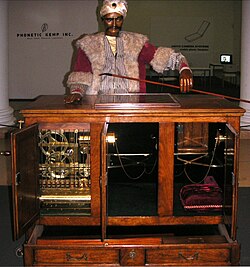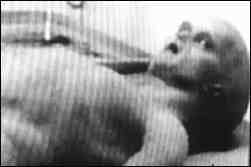Throughout history, there have been some hilarious, controversial, and confusing hoaxes that have been created. Hoaxes are different from urban legends, rumors, pseudoscience, or even jokes since a hoax is a deliberate and intentional attempt to create something that is false but present it as the truth. We will look at ten of the most interesting hoaxes that fooled a lot of people.
1. The Turk
In 1770, Wolfgang von Kempelen debuted the Mechanical Turk, also called the Automaton Chess Player or simply the Turk. The debut was made at Schönbrunn Palace in order to impress Empress Maria Theresa, and also in reaction to an illusion show put on by François Pelletier. Kempelen said that he would invent something that would be better than Pelletier's illusions, and six months later, the Turk made its debut.
The Turk itself consisted of a cabinet and a life-size model of a man. The model had a turban, a beard, and robes (all supposedly authentic of Turkish people at the time). The model's right arm would be outstretched across the cabinet, and the left arm would be bent and holding a three foot long smoking pipe. The cabinet itself was 3 1/2 feet long, 2 feet wide, and 2 1/2 feet high. On the opposite side of the model were two doors and one drawer. The drawer could hold the chess board and pieces when not playing.
 |
| An engraving of the Turk |
The left side door opened to show gears that looked like clock gears. There was a door on the back side of the cabinet that looked into the gears too. This way, if they were opened at the same time, one could see straight through and see the gears all the way through. The right hand side had a cushion and held spare parts for the machine. When opened from the front, a clear unobstructed view could be seen through to the robe of the Turk.
After it's 1770 debut, Kempelen lost interest in it, even though it's popularity spread. In the 1770's, only one challenger faced the Turk: a Scottish noble. Following the match, Kempelen disassembled the Turk and tried to move on. However, in 1781, Emperor Joseph II ordered Kempelen to bring the Turk to Vienna, which he reluctantly did. Following the successful showing of the Turk to Grand Duke Paul of Russia, Kempelen was recommended to tour Europe with the Turk. Kempelen was hesitant, but finally agreed. In 1783, the Turk began a tour of Europe, beginning in Paris. It then went to London, where the first suggestions came up that the Turk was a hoax. These allegations weren't proven, and the tour continued to Leipzig, Dresden, Amsterdam, and other cities. Following the tour, the Turk sat unused until Kempelen's death in 1804.
Following Kempelen's death, his son sold the Turk to Johann Nepomuk Mälzel, a musician who was interested in odd machines. Mälzel had once before tried to buy the Turk before Kempelen died, but Kempelen asked for too much (his son sold it for half as much to Mälzel). Mälzel then had the task of repairing the Turk and learning its secrets, which he did. In 1809, Napoleon Bonaparte came to Schönbrunn Palace and played the Turk. There are several different versions as to the outcome of the match, but all of them end with Napoleon convinced of the Turk's validity. In 1811, Mälzel brought the Turk to Milan where it played the Viceroy of Italy, who offered to buy it at three times the amount Mälzel paid for it. Supposedly, Mälzel agreed, but bought it back four years later. In 1819, Mälzel took the Turk on a tour of the United Kingdom. At this time, Mälzel changed two things: the Turk's opponent was allowed to move first, and the king's bishop's pawn was eliminated from the Turk's side, which presented a huge handicap against the Turk. With this handicap, however, the Turk was 45-3-2. In the 1820's, Mälzel took the Turk to the United States and toured it as far west as the Mississippi and as far north as Canada. In 1838, Mälzel died on a ship, leaving the Turk to the ship captain.
The Turk ended up in the hands of Mälzel's friend John Ohl, who tried to sell it for the ship captain, but ended up buying it himself. He quickly sold it to Dr. John Kearsley Mitchell who restored the Turk and allowed for the occasional challenge, but he eventually donated it to the Chinese Museum, owned by Charles Willson Peale. The Turk was soon nearly forgotten and ended up in a corner of the museum, taking up dust. In 1854, a fire broke out and burned the Turk, completely destroying it. In 1984, a man named John Gaughan spent $120,000 of his own money to make a working replica of the Turk, complete with the original chess board from the real Turk (which was stored separately in 1854). It took five years, but it debuted in 1989.
So, you're probably wondering at this point, how is this a hoax? It's a hoax because there was a man in the model of the Turkish man. How can someone see through the cabinet and not see him? Simple. He was able to conceal himself carefully when someone looked through. The man inside could also communicate with the man on the outside (whether it be Kempelen or Mälzel) through a code of number sequences. This dial of numbers was explained to be just computations from the Turk's mechanisms, but it really was a back and forth code between the two men. And who was inside? It is still a mystery who was inside the Turk model while Kempelen owned it, but while Mälzel owned it, a number of well-known chess masters took on the reigns of the Turk, one of which was William Schlumberger, who died after the Turk visited Havana, Cuba, which left Mälzel dejected (because he had no operator) before his own death.
 |
| The reconstructed Turk by Gaughan |
The truth of the Turk was guessed at for many years, but the revelation of the hoax was revealed through a series of articles by Dr. Silas Mitchell, the son of the last private owner Dr. John Kearsley Mitchell. He felt that chess players should know the truth. The articles weren't written until after the fire that destroyed the Turk. In 1859, William Kummer, who worked as an operator of the Turk under Mitchell, revealed that there was a candle inside the cabinet to allow him to see. A tube was rub up through the Turk and out through the top of the turban. The smoke was mixed with smoke made on the outside so that no one can see where it was coming from.
All in all, the Turk fooled a lot of people for a very long time. The amazing skills of the Turk had people fooled into thinking a machine was that advanced (it was even able to successfully complete the knight's tour on a chessboard). Lately, IBM has created Deep Blue which is a computer that actually can compete with human players in chess.
Bet you didn't know that!






